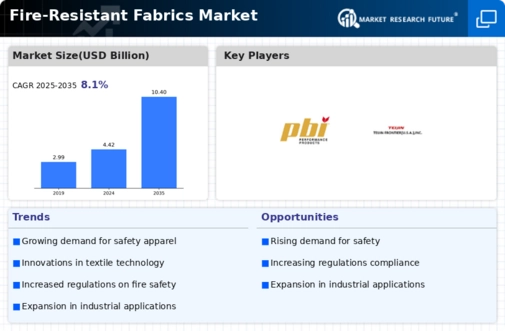Market Analysis
In-depth Analysis of Fire Resistant Fabrics Market Industry Landscape
The market dynamics of fire-resistant fabrics are influenced by various factors that impact supply, demand, pricing, and competition within the industry. These dynamics are crucial for businesses operating in this sector to understand in order to make informed decisions and remain competitive in the market.
The growing regulation on work safety coupled with the increasing adoption in the industrial sector are the major factors
Firstly, regulatory standards play a significant role in shaping the market dynamics of fire-resistant fabrics. Governments and regulatory bodies around the world enforce strict safety regulations for industries where workers are exposed to fire hazards, such as oil and gas, construction, and manufacturing. Compliance with these standards drives the demand for fire-resistant fabrics as companies strive to ensure the safety of their employees and avoid regulatory penalties. Changes or updates to these regulations can have a direct impact on the demand for fire-resistant fabrics, driving market growth or contraction accordingly.
Secondly, technological advancements and innovations in fabric manufacturing contribute to the market dynamics of fire-resistant fabrics. Manufacturers are constantly researching and developing new materials and production techniques to enhance the protective properties, comfort, and durability of fire-resistant fabrics. These innovations allow companies to differentiate their products in the market, meet evolving customer needs, and gain a competitive edge. Additionally, advancements in flame-retardant additives and coatings enable the production of fire-resistant fabrics that are more effective and environmentally friendly, further driving market growth.
Thirdly, market dynamics are influenced by the overall economic environment and industry trends. Economic factors such as GDP growth, industrial output, and consumer spending impact the demand for fire-resistant fabrics across various end-use industries. For example, during periods of economic expansion, construction and manufacturing activities typically increase, driving the demand for fire-resistant fabrics for use in protective clothing and equipment. Conversely, economic downturns may lead to a slowdown in industrial activities and a decrease in demand for fire-resistant fabrics. Moreover, industry trends such as the adoption of sustainable practices and the rise of e-commerce also shape the market dynamics by influencing consumer preferences and purchasing behavior.
Fourthly, competition within the fire-resistant fabrics market is another key dynamic that impacts industry players. The market is characterized by the presence of numerous manufacturers, suppliers, and distributors competing for market share. Competition intensifies as companies vie to offer superior products, competitive pricing, and efficient distribution channels to attract customers. Additionally, mergers, acquisitions, and partnerships among industry players can reshape the competitive landscape and impact market dynamics by consolidating market share or enabling companies to access new markets and technologies.
Finally, environmental and sustainability considerations are increasingly influencing the market dynamics of fire-resistant fabrics. As awareness of environmental issues grows, customers are demanding products that are produced sustainably and have minimal impact on the environment. This trend is driving manufacturers to adopt eco-friendly production processes, source sustainable materials, and develop recyclable or biodegradable fire-resistant fabrics. Companies that prioritize sustainability are likely to gain a competitive advantage and capitalize on growing market demand for environmentally responsible products.






Leave a Comment